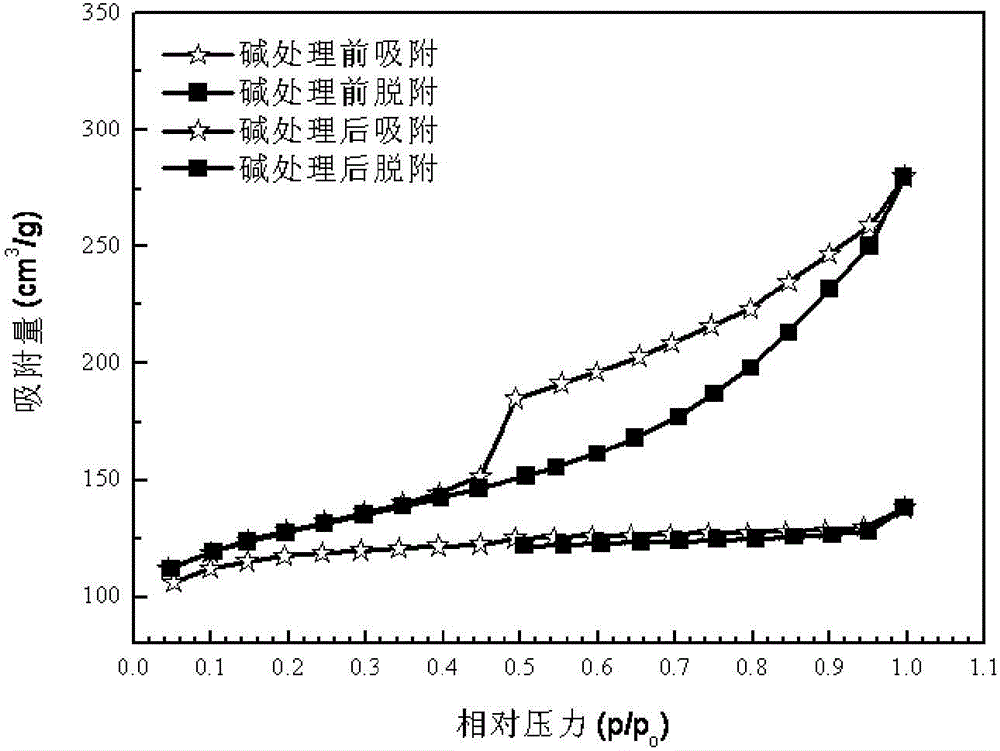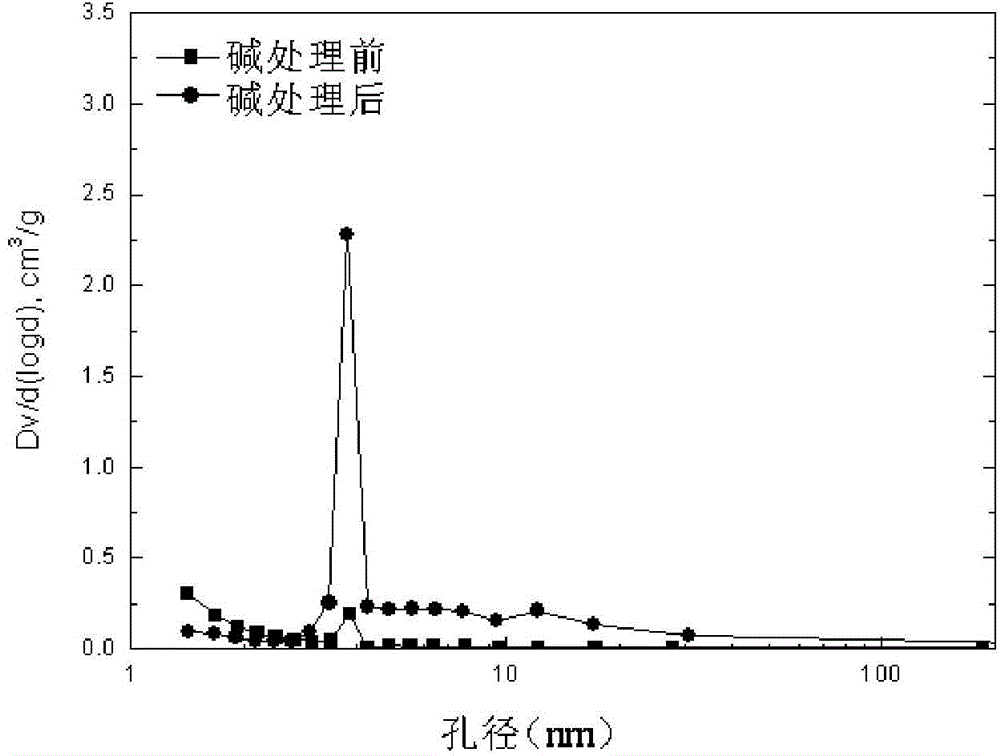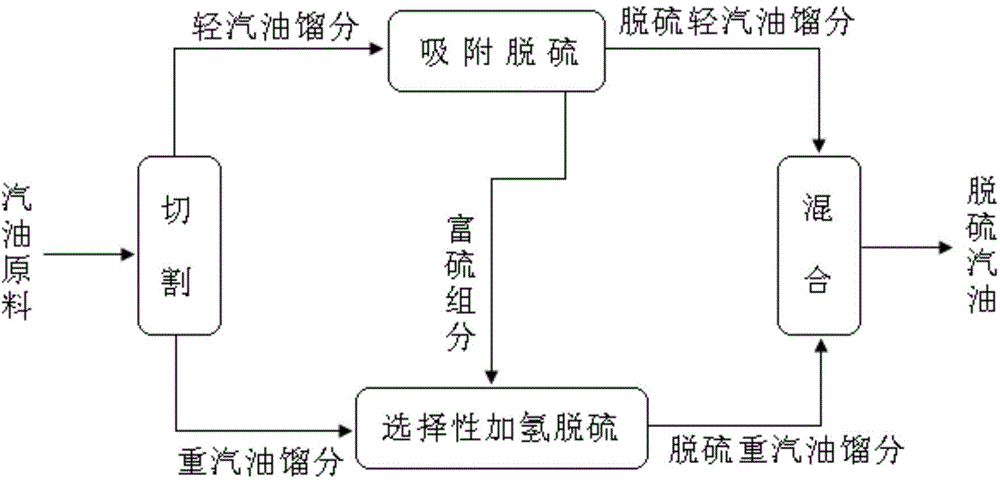Gasoline desulfurization method
A gasoline and heavy gasoline technology, applied in the field of desulfurization, can solve the problems of limited desulfurization depth and octane number loss, and achieve the effects of mild process operating conditions, high sulfur capacity, and avoiding waste of raw materials
- Summary
- Abstract
- Description
- Claims
- Application Information
AI Technical Summary
Problems solved by technology
Method used
Image
Examples
Embodiment 1
[0061] 1. Preparation of desulfurization adsorbent
[0062] 1) Preparation of alkali-treated molecular sieve and activated carbon
[0063] After heating two 500mL NaOH solutions with a concentration of 0.3mol / L in a water bath to about 70°C, add 25g of ZSM-5 molecular sieve and 25g of activated carbon to them respectively, stir for about 200 minutes, and immediately cool the mixture in an ice bath. to normal temperature, filter and wash the filter cake with deionized water for several times until the pH value of the filtrate is about 7, then place the obtained filter cake in an oven at 110°C for 4 hours to obtain alkali-treated ZSM- Type 5 molecular sieve and activated carbon treated with alkali; Among them, the adsorption-desorption isotherms and pore size distribution curves of ZSM-5 molecular sieve before and after alkali treatment are shown in figure 1 and figure 2 .
[0064] In addition, ASAP2000 automatic physical adsorption instrument was used to measure the specifi...
Embodiment 2
[0090] 1. Preparation of desulfurization adsorbent
[0091] 1) Preparation of alkali-treated molecular sieve and activated carbon
[0092] After raising the temperature of two 500mL NaOH solutions with a concentration of 0.2mol / L in a water bath to about 80°C, add 25g of Y-type molecular sieve and 25g of activated carbon to them respectively, stir for about 120 minutes, and immediately cool the mixture to room temperature in an ice bath , filter and wash the filter cake with deionized water for several times until the pH value of the filtrate is about 7, then place the obtained filter cake in an oven at 120°C for 3 hours to obtain alkali-treated Y-type molecular sieve and The specific surface area and pore size distribution of alkali-treated activated carbon; Y-type molecular sieve and activated carbon are shown in Table 3.
[0093] Table 3 Specific surface area and pore size of Y-type molecular sieve and activated carbon
[0094]
[0095] 2) Preparation of composite carr...
Embodiment 3
[0113] 1. Preparation of desulfurization adsorbent
[0114] 1) Preparation of alkali-treated molecular sieve and activated carbon
[0115] After raising the temperature of two 500mL NaOH solutions with a concentration of 0.2mol / L in a water bath to about 70°C, add 25g of ZSM-5 molecular sieve and 25g of activated carbon to them respectively, stir for about 90 minutes, and immediately cool the mixture in an ice bath. to room temperature, filter and wash the filter cake with deionized water for several times until the pH value of the filtrate is about 7, then place the obtained filter cake in an oven at 120°C for 3 hours to dry;
[0116] The ZSM-5 type molecular sieve obtained and the active carbon obtained repeat the above-mentioned steps once respectively (i.e., alkali treatment twice), and the ZSM-5 type molecular sieve through alkali treatment and the active carbon through alkali treatment are obtained; the ZSM-5 type molecular sieve and active carbon The specific surface a...
PUM
 Login to View More
Login to View More Abstract
Description
Claims
Application Information
 Login to View More
Login to View More - R&D
- Intellectual Property
- Life Sciences
- Materials
- Tech Scout
- Unparalleled Data Quality
- Higher Quality Content
- 60% Fewer Hallucinations
Browse by: Latest US Patents, China's latest patents, Technical Efficacy Thesaurus, Application Domain, Technology Topic, Popular Technical Reports.
© 2025 PatSnap. All rights reserved.Legal|Privacy policy|Modern Slavery Act Transparency Statement|Sitemap|About US| Contact US: help@patsnap.com



